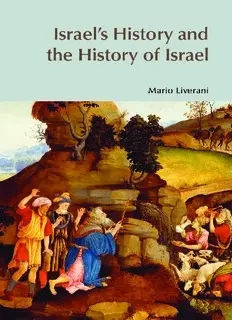Table Of ContentISRAEL’S HISTORY
AND THE HISTORY OF ISRAEL
BibleWorld
Series Editors: James Crossley, University of Sheffield; Philip R. Davies, University
of Sheffield
BibleWorld shares the fruits of modern (and postmodern) biblical scholarship not
only among practitioners and students, but also with anyone interested in what
academic study of the Bible means in the twenty-first century. It explores our
ever-increasing knowledge and understanding of the social world that produced
the biblical texts, but also analyses aspects of the bible’s role in the history of our
civilization and the many perspectives – not just religious and theological, but
also cultural, political and aesthetic – which drive modern biblical scholarship.
Published
Sodomy: Yours Faithfully:
A History of a Christian Biblical Myth Virtual Letters from the Bible
Michael Carden Edited by: Philip R. Davies
The Apostle Paul and His Letters The Origins of the ‘Second’ Temple:
Edwin D. Freed Persian Imperial Policy and the
Rebuilding of Jerusalem
Diana Edelman
An Introduction to the Bible The Morality of Paul’s Converts
(Revised edition) Edwin D. Freed
John Rogerson
The Mythic Mind History, Literature and Theology in
Essays on Cosmology and Religion in the Book of Chronicles
Ugaritic and Old Testament Literature Ehud Ben Zvi
N. Wyatt
Sectarianism in Early Judaism Symposia
Sciological Advances Dialogues Concerning the History
Edited by David J. Chalcraft of Biblical Interpretation
Roland Boer
Jonah’s World Uruk
Social Science and the Reading of The First City
Prophetic Story Mario Liverani
Lowell K. Handy
Women Healing/Healing Women
The Genderisation of Healing in Early Christianity
Elaine Wainwright
ISRAEL’S HISTORY
AND THE HISTORY OF ISRAEL
MARIO LIVERANI
TRANSLATED BY CHIARA PERI AND PHILIP R. DAVIES
Published by
UK: Equinox Publishing Ltd
Unit 6, The Village,
101 Amies St.,
London, SW11 2JW
www.equinoxpub.com
First published in Italian in 2003 by Gius. Laterza & Figli Spa, Roma-Bari,
entitled Oltre la Bibbia: Storia Antica di Israele. This translation is published by
arrangement with Gius. Laterza & Figli Spa, Roma-Bari.
First published in English in hardback in 2005 by Equinox Publishing Ltd. This
paperback edition published in 2007.
© 2003 Gius. Laterza & Figli Spa, Rome-Bari
This translation © Chiara Peri and Philip R. Davies 2005.
All rights reserved. No part of this publication may be reproduced or transmitted
in any form or by any means, electronic or mechanical, including photocopying,
recording or any information storage or retrieval system, without prior permis-
sion in writing from the publishers.
British Library Cataloguing-in-Publication Data
A catalogue record for this book is available from the British Library.
ISBN 978 1 84553 341 0 (paperback)
Typeset by CA Typesetting Ltd, www.publisherservices.co.uk
Printed and bound in Great Britain by Antony Rowe, Chippenham, Wiltshire
eISBN: 1845534840
All kingdoms designated by the name of Assyria are so called
because they enrich themselves at Israel's expense…all kingdoms
designated by the name of Egypt are so called because they per-
secute Israel.
(Genesis Rabbah 16.4)
CONTENTS
List of Tables and Illustrations ix
Foreword xv
Abbreviations xix
IMPRINTING
Chapter 1
PALESTINE IN THE LATE BRONZE AGE
(FOURTEENTH–THIRTEENTH CENTURIES) 3
Part I
A NORMAL HISTORY
Chapter 2
THE TRANSITION (TWELFTH CENTURY) 32
Chapter 3
THE NEW SOCIETY (c. 1150–1050) 52
Chapter 4
THE FORMATIVE PROCESS (c. 1050–930) 77
Chapter 5
THE KINGDOM OF ISRAEL (c. 930–740) 104
Chapter 6
THE KINGDOM OF JUDAH (c. 930–720) 128
Chapter 7
THE IMPACT OF THE ASSYRIAN EMPIRE (c. 740–640) 143
Chapter 8
PAUSE BETWEEN TWO EMPIRES (c. 640–610) 165
viii Israel’s History and the History of Israel
Chapter 9
THE IMPACT OF THE BABYLONIAN EMPIRE (c. 610–585) 183
INTERMEZZO
Chapter 10
THE AXIAL AGE 203
Chapter 11
THE DIASPORA 214
Chapter 12
THE WASTE LAND 231
Part II
AN INVENTED HISTORY
Chapter 13
RETURNEES AND ‘REMAINEES’: THE INVENTION OF THE PATRIARCHS 250
Chapter 14
RETURNEES AND ALIENS: THE INVENTION OF THE CONQUEST 270
Chapter 15
A NATION WITHOUT A KING: THE INVENTION OF THE JUDGES 292
Chapter 16
THE ROYAL OPTION: THE INVENTION OF THE UNITED MONARCHY 308
Chapter 17
THE PRIESTLY OPTION: THE INVENTION OF THE SOLOMONIC TEMPLE 324
Chapter 18
SELF-IDENTIFICATION: THE INVENTION OF THE LAW 342
EPILOGUE
Chapter 19
LOCAL HISTORY AND UNIVERSAL VALUES 363
Bibliography 369
Index of References 407
Index of Names of Persons and Deities 415
Index of Placenames 423
LIST OF TABLES AND ILLUSTRATIONS
1. Tables
1. Correlation of historical and biblical periodization (Author). 8
2. Chronology of the ‘formative period’ (Author). 80
3. Chronology of the Kingdom of Israel 950–720 (Author). 106
4. Demographic chart of Palestine in the eighth century
(M. Broshi and I. Finkelstein, BASOR 287 [1992], 54). 123
5. Chronology of the Kingdom of Judah, 930–640 (Author). 129
6. Chronology of the Near East 650–525 (Author). 185
7. Chronology of imperial expansion (Author). 198-199
8. Chronology of the Prophets (Author). 224
9. The patriarchal genealogies and the nations related by
descent (Author). 259
10. Chronology of the Book of Judges (Author). 297
11. Tribal lists in the Bible (Based on K.L. Sparks, Ethnicity
and Identity in Ancient Israel, Winona Lake: Eisenbrauns,
1998, 298). 303
12. Judah in the Persian period, 540–330 (Author). 310
2. Figures
1. Relief map of Palestine, with reference grid (Author:
drawn by Serena Liverani). 5
2. Late Bronze Age Palestine: distribution of settlements
and probable boundaries (north on the left, south on
the right) (I. Finkelstein, UF 28 [1996], 254-55). 11
3. Egyptian domination in the Levant: the campaigns of
Thutmoses III and the ‘provinces’ of the Amarna Age
(Author: drawn by Serena Liverani). 13
4. Egyptian domination: forms of homage (G.T. Martin, The
Hidden Tombs of Memphis, London: Thames & Hudson,
1991, fig. 49). 14

